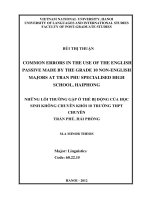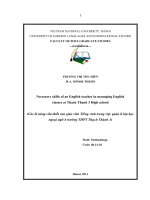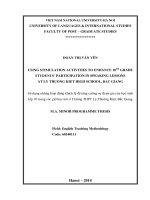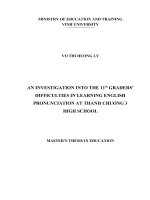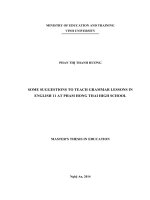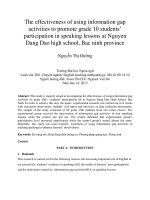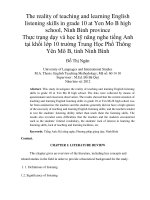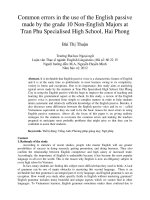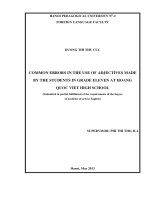Some suggestions to teach grammar lesons in english 11 at pham hong thai high school
Bạn đang xem bản rút gọn của tài liệu. Xem và tải ngay bản đầy đủ của tài liệu tại đây (449.83 KB, 87 trang )
MINISTRY OF EDUCATION AND TRAINING
VINH UNIVERSITY
PHAN THỊ THANH HƯƠNG
SOME SUGGESTIONS TO TEACH GRAMMAR LESSONS IN
ENGLISH 11 AT PHAM HONG THAI HIGH SCHOOL
MASTER'S THESIS IN EDUCATION
Nghệ An, 2014
MINISTRY OF EDUCATION AND TRAINING
VINH UNIVERSITY
PHAN THỊ THANH HƯƠNG
SOME SUGGESTIONS TO TEACH GRAMMAR LESSONS IN
ENGLISH 11 AT PHAM HONG THAI HIGH SCHOOL
Major: Teaching English to Speakers of Other Languages (TESOL)
Code: 60 14 01 11
MASTERTHESIS IN EDUCATION
SUPERVISOR: TRẦN BÁ TIẾN, Ph.D.
Nghệ An, 2014
DECLARATION
I certify that this study is entirely my own work. I have provided fully
documented references to the work of others. The material in this study has not
been submitted for assessment in any other formal course of study.
Author
Phan Thị Thanh Hương
i
ACKNOWLEDGEMENTS
I am, first of all, particularly indebted to my supervisor, Dr.Tran Ba Tien, for
his invaluable advice, instructions and correction, excellent suggestions and
constant encouragement during the research period. Without his guidance and help,
this work would not have been accomplished.
Secondly, my sincere thanks also go to all the lecturers who have been
teaching K20 MA course in Vinh University and the post-graduate staff for their
administrative assistance to the success of the course.
Besides, I would like to give my heartfelt thanks to all the teachers and the
students at Pham Hong Thai High School in Hung Nguyen, who willingly
participated in the study. I thank them for their time, patience and willingness in
completing the questionnaires, answering the questions and sharing their classrooms
with me.
Last but not least, I would like to convey my deepest gratitude to my parents,
my husband and my son, and for their constant support and thorough understanding.
Their great encouragement and love have helped me to overcome the difficulties
during my study.
ii
ABSTRACT
Grammar always plays an important part in teaching and learning English.
However, how to create students’ motivation in learning grammar lesson is not
simple. This study is concerned with the communicative activities in teaching
grammar as an effective method to create students’ motivation and improve
students’ understanding of the lesson. The benefits of using communicative
activities are affirmed again in this thesis through the former grammarians’ studies
and the researcher’s carried out at Pham Hong Thai High School, Hung Nguyen
district. These benefits bring considerable effectiveness to teachers and students in
teaching and learning grammar. In order to achieve this aim, the researcher carries
out observing classes, interviewing, questionnaires closely both teachers and
students, giving questionnaires to them, etc to have necessary findings and
analysis. The researcher also suggests the suitable measures to overcome difficulties
in using communicative activities in class successfully, and the examples of using
communicative activities to teach grammar points in Tieng Anh 11.
iii
TABLE OF CONTENTS
4.6.3.4. Picture Dictation 59
4.6.36. Information Gap 61
4.6.3.7. Telling Story 63
4.6.3.7. Responding game 64
4.6.3.9. Matching game 65
ABBREVIATIONS
CLT: Communicative Language Teaching
ELT: English language teaching
GTM: Grammar- Translation method
DM: Direct method
AM: Audio-Lingual method Audio
iv
LIST OF FIGURES AND TABLES
4.6.3.4. Picture Dictation 59
4.6.36. Information Gap 61
4.6.3.7. Telling Story 63
4.6.3.7. Responding game 64
4.6.3.9. Matching game 65
v
Chapter 1
INTRODUCTION
1.1. Rationale of the study
Today, English has become one of the most important languages to
communicate from this country to another country and people focus on learning this
language with different purposes .For whatever purposes they have, English is the
most useful means to achieve the goals. Besides the aim of passing their exams and
getting some further studies for their future life, all students have a desire to be
integrated into the culture, the civilization, and the people of English speaking
countries.
The more society develops, the more important part communication plays in
every field of life: home school, work and beyond. Through communication, we can
change our thoughts, opinions, and information by speech, writing or signs. It is
only through communication that collaboration and cooperation occur. Therefore,
the author has really been interested in communication in learning language through
which people of different nations can communicate or exchange the materials and
spiritual values, make their knowledge and culture richer and more diversified.
Aware of language’s function as a means of communication, many
researchers have been involved in the study of how to develop communication to
language learners. This is the first time the author has had a chance to learn
“Language teaching theory” and she has found that it is a very important material
for everyone who becomes teacher of English since it is a good way to help learners
practice communicative skills.
In addition, in my experience, after 7 years of teaching English by using the
new English textbooks at Pham Hong Thai High School, the researcher observed
that the teachers and learners have to face a number of difficulties not only in
teaching and learning the four language skills but also in teaching and learning
grammar during the Language Focus lessons. Specially, one of the problems
1
generally faced by most of the teachers of English at the secondary school is the
poor standard of the students. Students are even ignorant of the basic rules and
structural patterns which they are supposed to have learnt at the school level .Some
students are shy to use Enghlish in class, these are so serions prollems that the
reasearcher has been thinking about the question: Why do students fail in
communicating? How do teachers apply communicative language teaching in
grammar lessons? What activities can help them to motivate in learning Enghlish
well?
For the above reasons, the researcher decides to choose the topic: “Some
suggestions to teach Grammar lessons in English 11” It is expected that this study
will find out the problems of teaching and learning grammar in Language Focus
lessons at Pham Hong Thai High School in order to contribute some immediate
solutions to make grammar lessons more successful and effective
1.2. Purposes of the study
The aims of the study are as follows:
- Investigate the difficulties in teaching and learning grammar
- Find out how the teachers and the students deal with grammar in the
“language focus” lessons
- To help teachers aware of the importance of grammar and applying
activities to teach grammar communicatively.
- To get some information about the real situation of teaching and learning
grammar with creating and applying activities.
- To suggest some useful activities to motivate students and improve the
ability of communication for learners in grammar lessons.
1.3. Research questions
Making the aims of study is more effective, the system of the research
questions has to be clear. Here are the rearch questions.
1. What are the learners' attidutes toward language focus lessons?
2
2. What are the difficulties in teaching and learning grammar in the
Language Focus lessons as perceived?
3. What is real situation of teaching and learning English grammar at Pham
Hong Thai High School?
4. What are communicative activities to be applied in grammar lessons?
1.4. Scope of the Study
As mentioned earlier, this study is only aimed at investigating the difficulties
of teaching and learning grammar in Language Focus lessons and giving some
solutions to make grammar lessons more effectively.
This study is limited to the teaching and learning difficulties with regard to
teaching and learning grammar in Language Focus lessons.
This study is a detailed survey at Pham Hong Thai High School in Hung
Nguyen district. Therefore, the findings of the study are not intended to be
generalized to other school contexts. Indeed the findings may not apply beyond the
actual participants in this particular study.
1.5. Significance of the Study
This study plays an important role in improving grammar teaching method to
students at Pham Hong Thai School. It aims to identify the problems and suggests
ways of improving them; therefore, this study mainly focuses on communicative
activities .It is hoped that this study will be beneficial in many ways. First,
participants in the study (the teachers and the learners at Pham Hong Thai High
School) will benefit immediately from the experience of reflection. Secondly, the
findings of the study will contribute information to make the application of CLT at
my school successful and effective.
1.6. Method of the Study
For the sake of the teaching and learning of English, as this study is carried
out, the author has applied the two methods: quantitative and qualitative. Then,
various instruments will be used to collect the data for the study from different
sources:
3
- Survey questionnaires to investigate the difficulties in teaching and learning
grammar in Language Focus lessons. In order to do the research, a lot of references
have been selected, read and filtered for information. Furthermore, a survey has
been done by providing a questionnaire for 5 teachers of English and another for
116 students at Pham Hong Thai. Questionnaires are delivered to the teachers to
investigate difficulties in teaching grammar communicatively that they face and
solutions that should be implemented. Questionnaires are delivered to the students
to find out the students’ attitudes to learning English grammar, their difficulties
confronted and solutions suggested by them.
-After that, she conducts a survey to get information about the real situation
of teaching and learning English grammar at Pham Hong Thai High School.All the
collected information and data have been analyzed and synthesized and the
suggested activities to teach grammar for 11
th
form classes are discussed. In
addition to these, the research paper will not be completed without the supervisor’s
help.
1.7. Design of the Study
The thesis consists of 5 main chapters. Chapter I, Introduction, deals with the
author’s reasons for choosing the topic of the study, the rationale, aims, scope,
significance, methodology and design of the study.
Chapter II, entitled Literature Review, provides an overview on the
theoretical background. Chapter III presents the methodology of the study. Chapter
IV is devoted to analyzing and discussing the findings of the study.
Chapter V, “Conclusion” is the summary of the main points presented in the
study. The study ends with the “References” which lists all the materials and
sources of the information used in the study and the “Appendix
4
Chapter 2
THEORETICAL BACKGROUND
2.1. English grammar
2.1.1. Definition of grammar
Grammar is understood in various ways. There have been a lot of ways to
define grammar – a very common and familiar term in language teaching and
learning.
According to Ur.P (1998), “grammar may be roughly defined as the way a
language manipulates and combines words (or bits of words in order to form
longer units of meaning”. For example, in English, the present form of the verb
“be” in the third person has two distinct forms; one is being used with singular
subject, and the other with a plural. If the plural “are” is combined with a singular
subject, the result is usually unacceptable or ungrammatical. Thus, a sentence like
“She are a teacher” is ungrammatical. The correct sentence is “She is a teacher”
Grammar can be seen as “the study and practice of the rules by which words
change their forms and are combined into sentences” from The Longman
Dictionary of Contemporary English (quoted in Harmer: 1987, p12). There are two
concentrated basic elements: the rules of grammar and the study and practice of the
rules.
As for Murcia (1988), grammar is “a subset of those rules which govern the
configurations that the morphology and syntax of a language assume.” (p16).
According to Lưu Quý Khương (2006), grammar is sometimes defined as
“the way words are put together to make correct sentences” Thus, in English, “Iam
a teacher” is grammatical, but “I a teacher”. On the other hand, “I are a teacher” are
not. We can, however, apply the term “grammatical” to units smaller than a
sentence. A brief phrase said or written on its own can be grammatically acceptable
or unacceptable on its own right. A tall woman sounds right but a woman tall is not.
The same may be true of single words: compare “went” with “goed”.
5
All the ideas mentioned above agree on a point that is grammar is a set of
rules which form words and make sentences from words. This help to orient
language teachers to the focus of grammar teaching
Most language learners and teachers agree that mastering the grammar of a
language may form part of the knowledge of it. However, there exist some
controversial opinions about the teaching of grammar. One of the biggest
challenges to the necessity of grammar teaching comes primarily from Krashen
whose insistence on the primacy of acquisition has tended to downplay the value of
deliberate grammar teaching. In Krashen and Tarrel’s influential Natural Approach,
it is claimed that learners need to be exposed to a lot of comprehensive and
meaningful input at a level just above their own for acquisition to take place. The
study of grammar has only secondary role in the language program with the goal to
produce optimal monitor–user, programmers who can use grammar as a supplement
to acquisition when they have time, when the focus is on form, and when they know
the rules (the Monitor Hypothesis, Krashen and Terrell,1983). Put another way,
grammar can be acquired naturally from meaningful input and opportunities to
interact in the classroom and grammatical competence can develop in fluency–
oriented environment without conscious focus on the language forms.
Admittedly, some learners acquire second language grammar naturally
without being taught. Immigrants to the United States (especially young ones) who
attain proficiency in English on their own can be a good example of naturalistic
acquisition (Lightbown and Spada, 1999, p.60). But this is not true for all learners.
Among the same immigrants are learners who may achieve the proficiency in
English but that English is far from accurate.
In fact, grammar is one of the key components of a language. Thus, one
cannot master a language without the knowledge of its grammar. Partly thanks to
grammar, language can function as a means of communication, especially in written
language. A person cannot write well if he lacks the knowledge of grammar. From
my observation and my experience, I find it necessary to teach grammar lessons. I
6
intend to carry out my study. The first reason is that almost all the students in Pham
Hong Thai who come from the rural areas where they never have chance to learn
grammar sufficiently. Furthermore, the main objective of these students after
leaving the school is to communicate and attend some courses in English. For the
two reasons mentioned above, they can hardly do it without grammar. Moreover,
grammar exists to enable us to ‘mean’ and without it, it is impossible to
communicate beyond a very rudimentary level because speech seems to be no more
than sounds, writing seems to be no more than hieroglyphics. For all these reasons,
the teaching of grammar is quite important in English language teaching (ELT).
2.1.2. Grammatical structure
Grammatical structure is the building blocks of language. It is usually
understood as a system of interrelated words, which makes a meaningful utterance.
The thing is what elements are needed to hold the relations of utterances.
Grammatical structures not only have form, but they are also used to express
meaning “semantics” in context and appreciate use “pragmatics” which includes
social context, linguistic discourse and presupposition about context (Marianne
Celce, Murcia).
A particular form may be used for different appropriate uses depending on
the context. This means that the form of an utterance by itself does not determine
the function. In other words, we cannot fully explain the form of grammar while
ignoring meaning and use. We cannot account the form of an utterance by looking
only at its meaning or function.
Having controlled a skeleton structure, we can create dozens or even hundred
of utterances. If the students can handle a range of useful structures in a formulaic
way, be aware of the functional value of each and able to substitute the content to
meet their communicative needs, then they getting what they need.
2.1.3. The role of grammar in teaching and learning English
ESL teachers must frequently explain complex English grammar to their
students to help them speak and write. This course covers basic grammatical
7
concepts and exercises for ESL instruction. Ideas are presented to help educators
make grammar manageable for students; include grammar in their teaching of
written and spoken language; testing grammatical knowledge; and development of
materials that promote language fluency as well as accuracy.
It is quite reasonable to see the importance of grammar according to
Harmer’s viewpoint (1987):“Without some understanding of Grammar, students
would not be able to do anything more than utter separate items of language for
separate functions. The expression of functional language is only possible through
the use of the Grammar of the language”. (p.12)
Firstly, teaching grammar helps students understand how the language
works. Apart from vocabulary, students need to know grammar to understand how
it is written or how words are combined together to understand the proper meaning.
Without grammar or with a poor knowledge of grammar, they may get confused
with complicated expression In other words, the teaching of grammar means
providing students with opportunities to use English in a variety of realistic
situations to learn to communicate effectively. Appropriate grammar techniques are
embedded in meaningful, communicative contexts then contribute positively to
communicative goals and they also promote accuracy within fluent communicate
language use.
Secondly, according to Smith (2001), if teachers neither pay attention to
grammar nor create opportunities for learners to improve grammar, learners are
likely to stand the risk of fossilization or reach a point where they can cope with
level of communication that is demanded of them by making use of their existing
grammatical resources and communication strategies and probably with sufficient
fluency. Surely, they do not see the need to develop their linguistic abilities any
further (p.15).
In favour of the importance of grammar, Larsen – Freeman (1986) affirms
that grammar is regarded as a skill rather than an area of knowledge. Learners do
not simply store knowledge about the language and its use, they need also develop
8
an ability to do something. They must have a chance of learning situations to
overcome the knowledge problem. It is true to say that grammar is the fifth skill
besides four skills reading, writing, speaking, and listening. Skill development as
well as learning grammar takes practice. Grammar might not be taught only when
the students already possessed the knowledge and the ability to use the grammar
item in speech, writing and listening comprehension. In fact, grammar is the basis
for mastering four language skills. When we have concrete foundation of grammar,
we feel easy to advance (p.13).
In general, grammar is acknowledged to be of importance in language study
and in language teaching and learning in particular. Grammar is acquired naturally
from meaningful input and opportunities to interact in the classroom. More
especially, learners can improve their grammar competence in a suitable
environment without conscious focus on language forms. However, this partly
depends on the learning circumstances. As a result, grammar teaching gains its
significant role in English Language Teaching because highly developed language
skills are difficult to achieve without some knowledge of grammar
The position of grammar teaching in ELT is still controversial. Some people
refute the place of grammar teaching for the reason that the study of grammar is
neither necessary nor sufficient for learning to use a language.
In fact, grammar is one of the key elements of a language. Therefore, one
person can not master a language without the knowledge of its grammar. Thanks to
grammar, language partly can function as a means of communication, especially in
written language. One can not write well if he/she lacks the knowledge of grammar.
In speaking, though grammatical mistakes are sometimes acceptable, grammar
makes one’s speech better and more attractive, especially in formal situations.
Learners can not use words if they do not know how to put these words together.
The most important of teaching a language is to make students acquire and
use it. All languages have their own grammar. People teach English grammar to
make students improve their English. English must be taught because it promotes
9
better language skills. However, the most important is the application of them in the
language production.
For this reason, the teaching of grammar is very important in ELT. However,
this view is not shared by all researchers, scholars, and second language acquisition
researchers. The following sections review two opposing views on the role of
grammar.
2.2. Grammar teaching in the major teaching methods
There are many influential methods widely used by language teachers in the
world in general and in Vietnam in particular. The methods are now discussed in
this paper as follows: Grammar-Translation method (GTM);Direct method (DM)
and Audio-Lingual method (AM).
2.2.1. The Grammar- Translation method (GTM)
Traditional method or GTM was rooted in the formal teaching of Latin and
Greek and become popular in the late 19
th
century. According to Larsen- Freeman
(19864), the GTM was used for the purpose of helping students read and appreciate
foreign language literature. Through studying the grammar of the target language,
students would become more familiar with the grammar of their native language
and this helps them use their language more grammatically (p.4).
Advantages of the Grammar- Translation method
The strength of GTM is that it requires few resources so it is easy to apply
and cheap to administer. Thus, the method is still used in many places where the
class is large (more than 38 students), and there is a great shortage of teaching -
learning facilities and equipment, the teachers with inadequate speaking skill are
accustomed to setting teaching procedures.
Disadvantages of the Grammar- Translation method
This method, however, has certain disadvantages. According to Richards and
Rogers (1986), GTM obviously focuses on the form rather than the use of the target
language (p. 3). Students who are in this way did not have a chance to practice their
speaking and listening. Students learn rules of grammar and vocabulary without
10
much feeling of progress in the mastery of the target language can lead to the lack
of motivation in learning a language for their having little opportunity to express
themselves through it. They just learn what they have to without any creativeness.
The method creates frustration for students, for whom foreign language learning is a
tedious experience of memorization of new words and grammatical rules, while it
makes few demands on teachers. (Richards and Rogers, 1986, p.4)
2.2.2. The Direct method (DM)
In the late 19
th
century, increased opportunities among European create a
demand for oral proficiency in foreign language. The GTM was not very effective
in preparing students to use the target language communicatively and a new
method, namely DM was born. DM is characterized by the use of the target
language as a means of instruction and communication in the classroom, and by the
avoidance of the use of the first language and translation as a technique.
Advantages of the direct method
It brings the process of learning the target language close to that of first
language acquisition. Students are exposed to the target language situations.
Therefore, their ability to think in the target language is developed. River (1981)
claims that “at its best, DM provides an exciting and interesting way of learning a
language through activity. It has proved to be successful in releasing students from
the inhibitions all too often associated with speaking another tongue, particularly at
the early stage".
Disadvantages of the direct method
Though there is a development in students’ thoughts in the target language, it
has two- sided effect. Students may develop inaccuracies if they are not properly
guided. This is the result if their trying to express themselves in the target language
with insufficient knowledge about the language. Because all statements they learn
relate to the classroom. The teacher did not generally think of the students using of
the language beyond the classroom. Any connection with real life was expected to
come later and was not the business of the school. The graduation and sequences of
11
materials is not based on realistic spoken speech but artificial connected sentences.
The weakness of the method is also states in River (1983): “In the pure form of the
DM, insufficiency is made for systematic practice and requesting- practice of
structures in a coherent sequence. As a result, students often lack a clear idea of
what they are trying to do, and they make haphazard progress” (p.34).
2.2.3. The Audio-Lingual method (AM)
The AM derived from America during the World War II where there was a
need for people to learn foreign languages quickly for military purposes. It led to
the development of the AM which then has had a considerable influence on English
language teaching all over the world. This English teaching method puts listening
and speaking in the first place. It uses sentence pattern as the base of teaching and
try to avoid mother tongue in class. Attention is paid to the need for practice rather
than explanation about the language because the ability to use the language as a
means of communication is the ultimate aim.
Advantages of the Audio-Lingual method
The first and most successful point of this method is to develop students'
listening comprehension and fluency in speaking in the target language. Students
are encouraged by the sense of being able to use what they have learned in the very
early days of their study. In addition, the study is reinforced by repetition, so the
students have good repetition and this is suitable for learners of different abilities.
Another point is that, this method provides a good systematic progression of the
materials.
Disadvantages of the Audio-Lingual method
However, there still remain some problems. The success or failure of this
method depends largely on the qualities of the teachers and the availability of
resources. That is why Brumfit (1983) comments “the objective is generally the
mastery of sentence patterns rather than creative or communicative use of
language” (p.8).
12
Along the history of language teaching methodology, different teaching
methods have perceived grammar differently, especially its role and its teaching
methods. In this study, the researcher intends to present the teaching of grammar in
four major teaching methods, namely Grammar-Translation method, Direct
Method, Audio-lingual Method and Communicative Language Teaching approach.
The Grammar-Translation Method was derived from traditional approaches
to the teaching of Latin and Greek in the nineteenth century. This method used
grammar as the starting point for instruction. The class under this method began
with explicit grammar rules presentation, followed by practices involving
translation into and out of the student’s mother tongue (grammar is taught
deductively). Students’ native language is the language of instructions and mistakes
and errors must be avoided at any cost. The syllabus used was structural syllabus
(Richards and Rogers, 2002). Briefly, in this method grammar is considered
essential in foreign language teaching and there is an attempt to teach it in an
organized and systematic way. The best point of this method is that it helps learners
produce grammatically correct sentences and is easily used in large-sized classes;
however, learners taught with this method find it difficult to communicate in real
life and tend to be passive recipients of knowledge.
The Direct method emerged to challenge the way Grammar-Translation
Method focused exclusively on written language. The basic premise of the Direct
Method was that one should attempt to learn a second language in much the same
way as children learn their first language. The method emphasized oral interaction,
spontaneous use of language, no translation between first and second languages,
and therefore rejected explicit grammar teaching. Grammar is taught inductively in
the target language by asking and answering questions between teachers and
students in small and intensive classes (Richards and Rogers, 2002). An advantage
of the Direct method is that learning in the target language enables students to think
in the target language. Beside, it may be advantageous to a teacher using this
method not to know his students’ native language. However, the complete
13
avoidance of students’ native language may lead to the misunderstanding of rules
and frustration from students.
Evolving from the work of structural linguists and behavioral psychologists,
the Audio-lingual approach proposes that language performance consists of a set of
habits in the use of language structures and patterns. Grammar is taught inductively
with little or no grammatical explanations. Dialogues and drills form the basis of
audio-lingual classroom practice. After a dialogue has been presented and
memorized, specific grammatical patterns in the dialogue are selected and become
the focus of various kinds of drills and pattern-practice exercises. The focus of
instruction rarely moves beyond the sentence level (Celce-Murcia, 1991). It is
important to prevent learner from making errors because errors lead to the
formation of bad habits. When errors occur, they should be corrected immediately
by the teacher. The strong point of this method is that students can develop
listening and speaking proficiency at the same time they learn new structures;
however, the explicit use of the target language often leads to time consuming and
students might get bored with mechanical repetition or become well-trained
parrots.
2.3. Definition of CLT
Different authors view CLT differently. However, most definitions of CLT
come under its weak version which emphasizes the importance of opportunities to
use English for communicative purpose. Among the available definitions, the one
given by Nunan (1989) seems to be the most widely accepted and the most
favourable one.
“CLT views language as a system for the expression of meanings. Activities
involve oral communication, carrying out meaningful tasks, and using language,
which is meaningful to the learners. Objectives reflect the needs of the learners;
they include functional skills as well as linguistic objectives. The learner’s role is as
a negotiator. The teacher’s role is as a facilitator of the communication process.
Materials promote communicative language use” Nunan (1989, p.194).
14
2.3.1 Teaching Grammar in CLT
2.3.1.1 Grammar in CLT
An influential analysis of communicative competence is found in Canal and
Swain (1980, cited in Nguyen Thi Van Lam and Ngo Dinh Phuong, 2007), in which
four dimensions of communicative competence are identified. One of them is
“grammatical competence”. “Grammatical competence” refers to what Chomsky
calls linguistic competence and what Hymes intends by what is “formally possible”.
It is the domain of grammatical and lexical capacity.
As grammar is seen as a communicative system in CLT, it should derive
from realistic situations and be used for a concrete purpose to enable learners to
express meanings by using as much appropriate forms as possible. Activities
included in teaching grammar should enable students to become active (learning by
doing) and teacher should set grammar in relation to what they need and are
interested in.
One important thing when teaching grammar in communicative situation is
that errors should not be overestimated or overemphasized as this can result in a
stressful and fearful classroom climate. This goes against the general goal to make
students more confident and increase their motivation for language learning .
As far as grammar is concerned, CLT is an ideal choice, as it rather has the
learners in its centre than assessing the number of mistakes made. “Boring
grammar” can turn into various demanding, enjoyable games and tasks that fulfill
the goal to practice structures even better or equally well. Grammar examples are
taken from real life situations that make sense and are no longer meaningless or
boring invented illustrations. Furthermore, students learn that grammar is
meaningful and helps them to express their own ideas and achieve speaking goals
(grammar is a means to an end). In addition, rules that consider the functions and
notions of language are still relevant, but mainly taught by means of activities,
which facilitate their understanding.
15
2.3.1.2. Characteristics of CLT
In CLT, meaning is paramount. Wilkins (1972) classifies meaning into
notional and functional categories and views learning a second language as
acquiring the linguistic means to perform different kinds of functions. According to
Larsen- Freeman (1986), the most obvious characteristic of CLT is that “Almost
everything that is done with communicative intent”. Students use the language
through communicative activities (e.g. games, role- plays and problem-solving
tasks) (p.132)
From Morrow’s point of view (in Johnson and Morrow, 1981), activities that
are truly communicative have three features: information gap, choice, and feedback.
An information gap occurs when one person exchanges the information he has with
the one who does not.
Another characteristic of CLT is the introduction of authentic material. In
CLT, it is considered desirable to give learners the opportunity to genuine
communicative needs in realistic second language situations so that they develop
strategies for understanding language as actually used by native speakers (Canale
and Swain, 1980).
In addition, “activities in the Communicative Approach are often carried out
by students in small group” (Larsen- Freeman, 1986, p.132). Students are expected
to interact with one another, either through pair and group work or in their writing
(Finicchiaro and Brumfit, 1983). CLT favors interaction among small numbers of
students in order to maximize the time each student has to learn to negotiate
meaning. Teachers therefore select learning activities according to how well they
engage the students in meaningful and authentic language use rather than in the
merely mechanical practice of language patterns.
Another dimension of CLT is “its learner- centered and experience- based
view of second language teaching” (Richards & Rogers, 1986, p.69). According to
CLT theory, individual learners possess unique interests, styles, needs, and goals
that should be reflected in the design of instructional methods (Savignon, 1983).
16
Teachers are to develop materials based on the demonstrated needs of a particular
class. Students must be made to feel secure, unthreatened and non- defensive in a
CLT classroom, so teachers using CLT should avoid adopting a teacher- centered
authoritarian posture (Taylor, 1983).
Thus, Li (1998) reviews CLT characteristics based on the work of other
researchers such as Larsen- Freeman (1986), Richards and Rogers (1986) and
Thomson (1986) as follows:
- focus on communicative functions.
- focus on meaningful tasks rather than on language form.
- make tasks and language relevant to a target group of learners. through an
analysis of genuine, realistic situations.
- use the authentic from life materials.
- use group activities effectively.
- attempt to create a secure, non- threatening atmosphere.
2.4. Some General Principles of Grammar Teaching
According toThornbury.S $ Harmer. J (1999) in “How to teach grammar”,
the basic principles for grammar teaching are the E- factor (economy, ease,
efficacy), and the A- factor (appropriacy).
- Efficacy: Given that dealing with grammar is only a part of teachers’
activities, and given that classroom time is very limited, it would seem imperative
that whatever grammar teaching is done as efficiently as possible. If grammar
activity requires a great deal of time to set up or a lot of material, is it the most
efficient? When considering an activity for the presentation or practice of the
grammar the first question to ask is “How efficient is it?”
Economy: When presenting grammar, a sound rule of thumb is the shorter
the better. It has been shown that economy is a key factor in the training of
technique skills.
Ease: The ease factor recognise the fact that most teachers lead busy lives,
have many classes, and simply can not afford to sacrifice valuable free time
17
preparing elaborate classroom materials. Of course, the investment of time and
energy in the preparation of materials is often accompanied by a commitment on the
part of the teacher to making them work. However, realistically, painstaking
preparation is not always going to be possible. The easier an activity is to set up, the
better it is.
The A- factor: Appropriacy
No class of learners is the same, not only are their needs, interest, level and
goals going to vary, but their beliefs, attitudes and values will be different. Any
classroom activity must be evaluated not only according to criteria of efficiency, but
also of appropriacy. Factors to consider when determining appropriacy include:
- the age of the learners
- their level
- the size of the group
- the constitution of the group, e.g. monolingual or multilingual
- what their needs are, e.g, to pass a public examination
- the learners’ interests
- the available materials and resources
- cultural factor
- Educational context, e.g, private school or state school.
The teacher should furnish pupils with words to change the lexical
(semantic) meaning of the sentence pattern so that pupils will be able to use it in
different situations. He should assimilate the grammar mechanism involved in
sentence pattern and not the sentence itself.
Pupils learn a grammar item used in situations. For example, the Possessive
Case may be effectively introduced in classroom situations. The teacher takes or
simply touches various things and says this is Nina's pen. That is Sasha's exercise
book, and so on.
While preparing for the lesson at which a new grammar item should be
introduced, the teacher must realize the difficulties pupils will meet in assimilating
18
